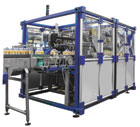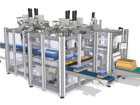
Innovations in case-packing infeeds, pack patterns, handling and more can help you efficiently accommodate retailers’ needs.

Brenton's S90 shrink wrapper handles all pack styles--trays, pads and bundles--giving packagers versatility in creating shelf-ready packs on the same system that runs other products.
While shelf-ready packs alleviate handling issues at the retailer end, they can impose unique challenges in a processor’s plant at the end of the packaging line.
So, we asked major case packing machinery manufacturers the following question:What challenges do shelf-ready packs present to case packers and how are today’s systems accommodating those needs? Here are their solutions.
Chris Calabrese, sales manager
Fallas Automation Inc.
254-772-9524; www.fallasautomation.com
The single-stack configuration, typically found in shelves, presents the speed problem in picks per minute for a typical vertical case packer which relies on picking one product at a time and placing it into a chamber and upending the shelf-ready pack (SRP) 90 degrees to cross-push the vertical stack into the case.
One solution is the Fallas R400-RT, which uses a racetrack (lug belt) to group the product into its complete stack vertically on the pick belt and then pick the entire group and top load into the SRP.
The shallow tray style SRP’s usually found at the end of aisle sometimes contain rigid cartons. The challenge is top loading the cartons into the tray without hitting the edge of the tray as they are typically a snug fit. Our solution is the standard R400 top load robot with a special shoehorn assembly that funnels the sides of the cartons into the tray.
Leo Robertson, vice president of engineering
Pearson Packaging Systems
800-732-7766; www.pearsonpkg.com
At Pearson Packaging Systems, we focus on top-load case and tray packing. Shelf-ready packaging applications offer several challenges. Perforations and cut-outs often needed for display purposes can reduce stacking strength and introduce difficulties with case or tray forming functions. Since the secondary container is to be used in a retail application, extreme care must be practiced to avoid any witness marks on display cases or trays.
Often several different pack patterns are used including stand-up, lay-down or alternating interleaved patterns requiring extreme flexibility in product placement capabilities. One of our most frequently applied units for the purposes of shelf-ready packaging is the model GTL-AN1. This case packer is designed to form, fill and seal cases or trays from a one piece corrugated paperboard blank.
Retail, club and convenience-style trays all use a wraparound format and offer several advantages that support the shelf-ready packaging concept. This format is well suited to support die-cut windows and tear-out perforations while continuing to offer superior stacking strength. The wraparound format often results in a significant reduction in corrugated paperboard over the regular-slotted container (RSC) format as well.
Mike Grinager, VP of technology, Brenton Engineering, A Pro Mach Co.
800-535-2730; www.brentonengineering.com
Marlon Largred, end-of-line regional sales manager, Pro Mach
Some challenges are: product does not come in the orientation in which it needs to be packed; shelf-ready patterns are not efficient; fast infeed speed makes it difficult to collate; and carton/case rate is slower than infeed, so the collating area becomes complicated.
Odd shapes and sizes of primary packaging could be an issue, too. For example, if a product is packaged in film, a vacuum pick may pucker it. Therefore, equipment manufacturers are forced to come up with different product handling methods.
Brenton has developed many solutions to accommodate customers’ display package needs, such as integrated robotics. Often display packs force manufacturers to pack different configurations in the same machine. Robots and advanced end-of-arm tooling (EOAT) provide flexibility.
Additionally, Brenton offers case and tray solutions for regular slotted containers (RSCs) and wraparound cases and trays. The Series 20 pouch case packer, for example, packs stand-up pouches in a display tray.
The tradeoff for an attractive shelf-ready pack is reduced stacking strength for shipping. We also have the capability to add pegs, shroud, tray/lid or bliss-style cases to reinforce panels or corners to increase shipping strength.

Two-axis robotic loading system works in conjunction with Oystar's A+F case/try packer to produce a variety of packs, including shelf-ready displays.
OYSTAR USA
732-536-8770; www.oystarusa.com
The main challenge is designing the necessary flexibility into the case packer that will allow it to easily and quickly adjust between not only shelf-ready display packs, but also various other types of cases and trays. The age of the club store now requires our customers to have the flexibility to offer all these shipper styles along with a maximum adjustment range for different case counts. The better they are able to do this, the more competitive they can be.
OYSTAR A+F case packing systems answers this challenge with the use of A+F’s TwinLine two-axis robotic loading system, working harmoniously with a servo-driven case/tray indexing line. These two systems allow the packer to easily adjust between packing into a large range of cases, trays or display packs, with a typical changeover time of less than 15 minutes.
John French, director, sales and marketing
BluePrint Automation
804-520-5400; www.blueprintautomation.com
What used to be a challenge, but is becoming more commonplace, is getting involved with these requests [for shelf-ready packs] up front, with the marketing and packaging engineers. This produces mutually beneficial results. The multiple faces and multiple stock-keeping units (SKUs) in one format has also allowed us to focus more on the multi-axis and/or vision guided side of our business to achieve the required shelf presence.
One customer required an end-of-aisle display case that could be taken right from the pallet and stacked in the store, but had facings on three sides of the case, so that no matter where it went on the shelf or end of aisle, the shoppers always saw a bag front facing. This is the popular three-sided club store display. Using our standard Swing machine, which allows for horizontal and vertical packing of bags specifically for displays, we made a small custom “innovation” that allowed us to simply achieve the three-sided display when required for this customer, and a standard single directional facing when required. Changeover was less than two minutes, no tools!

The CTD Combiner-Turner-Divider from KHS orients shelf-ready packs and feeds to final packing, such as case (including wraparound), tray, pad or film-only. System operates at 300-plus cycles per minute, depending on shelf- and final-pack configurations.
KHS USA Inc.
262-797-7200; www.khs.com/us
Capacity can be a challenge, especially in situations where the shelf-ready pack replaces the case pack. A case packer may run a 12- or 24-unit case pack. If the shelf-ready pack replaces the case pack and is fewer containers per pack (that is, 6 packs or 4 packs), the case packer may quickly run out of capacity, as it must run multiple rate of cases for same overall line filling rate of individual containers.
Possible solutions are:
• Changing from trays to pads. Eliminating the tray side walls allows certain tray/film machines to run pad/film in multiple lanes. Example, instead of running one case (six bottles leading by four bottles), you can run two lanes of packs (four bottles leading by three bottles) or other geometric combinations. Limitation is 80 to 100 cycles per minute, depending on bottle stability and other factors.
• Running film-only packs-allows for multiple lane operation-similar impact to above.
• Installing intermediate machines to create the shelf-ready units. Packs can be combined and run through the packer at original rates.
Handling of shelf-ready packs is another challenge. Assuming these packs are prepared by intermediate machines (paperboard or shrink-film multi-packers), they must be handled and laned into the format required for the case-pack pattern. Shelf-packs may be unstable pack patterns and suspect to damage. Additionally, the marketing department may dictate numerous versions of shelf packs that packaging lines must accommodate with high speed and fast changeover.
Possible solutions include:
• Laning systems, capable of forming various number of pack lanes.
• Fast-changeover conveyor systems, capable of gentle/accurate handling of packs in various lane configurations.
• Sophisticated line controls systems to operate and changeover both of above.
WEB EXCLUSIVE: 3 more tips
Bryan Sinicrope, vice president, sales and marketingA-B-C Packaging Machine Corp.
727-937-5144; www.abcpackaging.com
A-B-C is working with our customers to accommodate retailer requests. We have a new version of our Model 206 case packer to pack display trays that can be stacked as an aisle-end display or on the shelf. In most cases, the new packaging styles require modifications of the product accumulator for specific product orientation or pack style. This is not a major change for us, as it is something we consider on every case packing project. It is helpful if customers involve the machinery manufacturer in their “thinking stages” as we can often suggest design modifications that can achieve their goals and save money.
However, we are finding that customers want to skip the case packing step altogether and palletize shrink-wrapped multipacks, bottles in half-depth trays or, in some cases, individual products without exterior packaging. We have configured our palletizer infeeds to handle many package styles to achieve our customers’ goals.
One recent project was to palletize irregularly-shaped products, which required modifying the palletizer infeed and accumulation. The products required a tight pack on the pallet, which was provided by the automatic layer squaring feature on our palletizers.
Brian Sisko, product manager, dry end technology sales
Krones Inc.
414-409-4000; www.kronesusa.com
The Krones product profile has evolved to run shelf-ready packaging, from pick-and-place packers to solutions using continuous-motion packers forming the tray, wraparound blank or film around the containers. Here are some of the issues running shelf-ready containers and our solutions.
Issue: Conversion of RSC cases to shelf-ready.
Solution: The wraparound blanks replacing RSC cases are designed with perforations to tear-out, so display cases become shelf ready. Other wraparound blanks are redesigned as open top.
The vast variations of shelf-ready packaging requires flexibility in machinery. One example, the Krones Wrapapac WTS packer, is capable of handling both wraparound cases and trays with film. Another example: a Krones Variopac or Wrapapac packer can be designed with a combined infeed for packing loose containers and film-only bundles.
Issue: Weight reduction of beverage or food containers.
Solution: To handle the softer containers and packs, Krones offers an infeed that controls the container pressure per each individual lane prior to the packer.
Issue: Weight reduction of the film thickness.
Solution: The Variopac film wrapping system is capable of handling film thickness down to 1.5 mil. Because the thinner film might make it less desirable to carry the pack by the bulls-eye, Krones offers the integration of a handle application within the packer, instead of a separate machine downstream.
Issue: Elimination of corrugate tray or pad to film-only packs.
Solution: Krones Variopac packers can be designed to discharge trays or pads with film and film-only packs. These machines offer high speeds as film-only bundles can be handled in one, two or three packs per cycle.
Issue: Methods to increase package stacking strength.
Solution: To offset the lighter weight containers and reduced column strength of packs, Krones offers a robotic partition inserting system integrated and located prior to the Wrapapac wraparound packer or Variopac packer (for trays).
Jon Ballou, corporate vice president, sales and marketing
Douglas Machine Inc.
320-763-6587; www.douglas-machine.com
One of the biggest challenges we face is gaining clear definition from the end-user customer. Once we understand the customer’s needs, we apply appropriate technology to create their solution.
Since Douglas Machine has been handling and building the machinery for shelf-ready products for many years, we don’t find it difficult to produce the different types of shelf-ready packs such as wraparound cases with tear open fronts, [half-slotted container] HSC-style cases with removable lids, six-corner trays and tray/shroud. We do find more end users trying to combine shelf-ready packs with sustainability initiatives, such as packaging material reduction. Our Axiom series case/tray packers are ideal for shelf-ready packs. The all-servo technology gives us the flexibility we need to meet the end-user customer’s needs.
